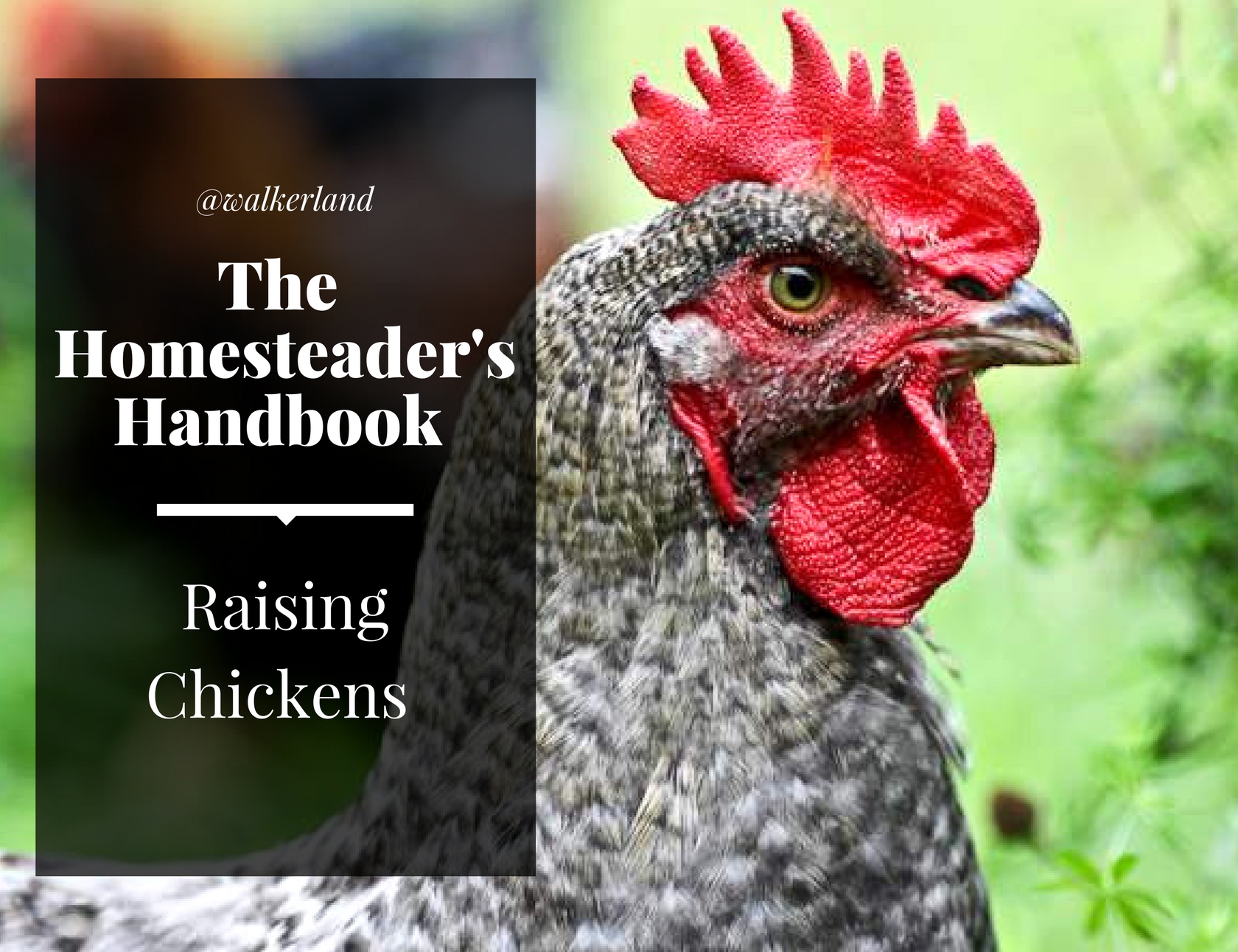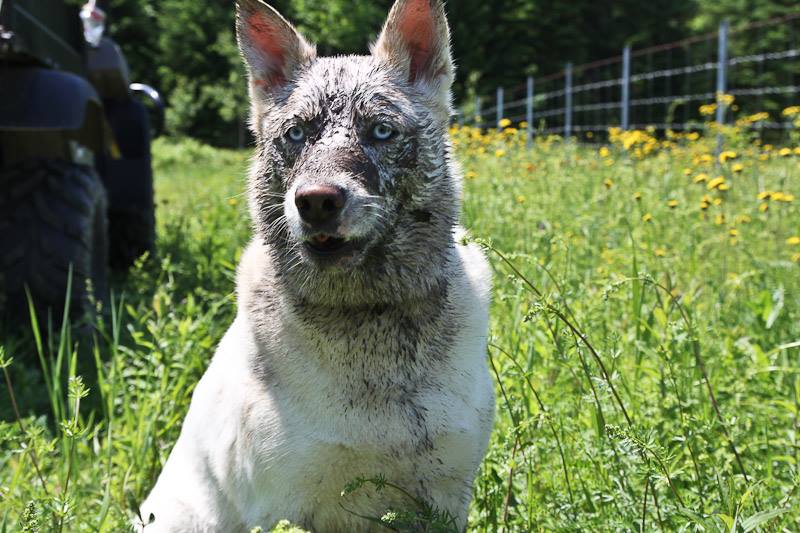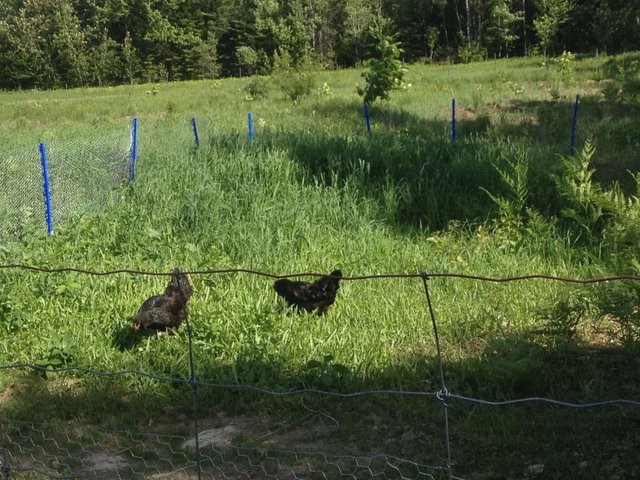The Homesteaders Handbook: Raising Chickens Part 4
.jpg)
This is the fourth part in a complete series on raising chickens! In this chapter we'll continue talking about chicken shelters: covering things like coop cleanliness, human health, free ranging compared to free run and more!
You can find earlier chapters in this series here
The Homesteaders Handbook: Raising Chickens Part 2 - Breeds, hybrid vs heritage and more
Food and Water Stations
As a rule we keep the food and water in the sheltered outdoor run. We do not keep any food in the coop. Some people even put the food away at night. The absence of food in the coop discourages vermin from making themselves comfortable which is something you want to deter at all costs.
Now one thing I must add is that I recently broke this rule. We had severe snow storms pass through here and I gave up trying to fight the never ending snowdrifts and moved the food and water into the coop. They have enjoyed two weeks of room service but we put it back outside where it belongs as soon as we could.

Coop Cleanliness
Good ventilation and proper sanitation are extremely important for maintaining a healthy flock. Remove damp bedding frequently and focus on keeping the coop clean and dry. The manure and bedding breaks down into amazing compost for your garden beds so be sure to create a compost pile.
It is a good idea to make the roosts in the coop removable so you can do thorough cleanings a few times each year, washing the roost bars down as well.
Chicken poop is quite messy and we have found that paint scrapers and drywall/putty knives work extremely well for scraping up anything stuck on the floor or walls.
Human Health
When cleaning the coop you should wear gloves and a good quality dust mask. I know some seasoned chicken keepers will scoff at this BUT you should know that It is possible to breathe in particles that will make you quite ill. In some cases you can develop long term respiratory illness. Always open coops doors and windows when you are working: ventilate! This is not uncommon with farm workers and I have met a backyard chicken keeper who is fighting an illness called Histoplasmosis. It most often impacts the lungs but can also effect your eyes, liver, central nervous system, skin, or adrenal glands. It thrives in moist environments like coops and animal bedding. The birds are not infected with it but they do carry it on their feathers.
Histoplasma capsulatum produces small spores called conidia. When these spores are inhaled, they are small enough to enter your lungs and start an infection. Many of these infections are easily overlooked because they either produce mild symptoms or none at all. On the extreme end, histoplasmosis can be severe and produce an illness similar to tuberculosis. Crazy right?
##An ounce of prevention is worth a pound of cure so I recommend that you wear a mask.
Predators & Protection
When planning your coop, run and pasture it is important that you consider their safety. Everything likes the taste of chicken and their presence will attract plenty of wildlife to your yard.
To protect our chickens they no longer have free run of the property. They have two main areas to frolic when they don't want to be in the coop
• Enclosed Run - The run is a sheltered area to protect them from the rain and sun while allowing them fresh air. The run is completely secure. Around the run we dug a trench a foot deep, and buried mesh wire (hardware cloth) and large rocks before filling it in with dirt. Nothing can dig it's way into the coop or the run (they have tried!) It is very secure.
• Free range area - We have a fenced outdoor pasture using step in posts and chicken wire. We do have electric fencing as well although we have not needed it. This is a temporary set up thrown up in an urgent response to our dog Molly deciding that she liked the taste of chicken one day. It is not entirely secure and we have had a few fence failures that inevitably resulted in chicken deaths. Half measures never work. They always fail. We will be rebuilding this properly in the spring with the same methods used for the enclosed run but no roof.
You pets can be trouble. Our dog Molly behaved perfectly with the chickens for many months. she would walk right past them ignoring them or she would watch them play with interest but never ever showing aggression. One day I looked out the window and there she was eating Agnes, my favourite hen.

Escapees & Barriers
Chickens can fly, to an extent. It's more like an extended feather assisted jump. It's not usually a graceful maneuver. They can use those wings to escape from their secure, predator proof area and they will attempt it if they see something they want on the other side of the fence. They can also to get into places you really don't want them such as your freshly planted vegetable garden. I still remember my husband looking out the window and saying “should the chickens be in the garden?” You should have seen me run. They can clean out a garden bed of tender greens fast. Really fast.
Free ranging chickens means that you will need to put up barriers between them and the gardens or places you don't want them to go. This is rather difficult on a homestead and in my experience chickens will work out ways to overcome any obstacles you put in their place.
Escape Prevention: If there is a way to escape, a chicken will find it. We have employed a variety of deterrents to keep the chickens from escaping and we have learned what works best by watching them escape. It has meant changing the design of the gate so they can't land on it and moving perches and other things that assist them with their escape. Leaping from one structure to another is not unheard of and is quite entertaining to watch.
Wing Clipping
One option for keeping your chickens in their designated areas is to clip the wings. The hardest pat of this process is catching the chickens. The downside of clipping their wings is that they can't flee predators quite as well. If you intend on clipping your chickens feathers take five minutes to watch a video before you do it. The main things to be aware of are which feathers to clip and how short. You want to cut only the long primary feathers. If you have dogs you will know that there is a white area of the nail that is safe to cut and above that there are veins that will cause bleeding if you cut into that area. It's the same with a birds quill. You will want styptic powder or corn starch handy to clot the blood if you do have a mishap.
Free Range
Initially we envisioned that our chickens would wander around pecking in the grass and foraging to their hearts content. Soon we realized that they were eating the plants growing in our gardens and they were pooping everywhere and on everything: fences, gates, walkways, porches, you name it. I really did not like the poop on everything trend that was starting. To make matters worse, we live in a heavily wooded area and began to notice animal tracks around the chicken coop. The chickens were being stalked which meant that we had to be really watchful of them when they were out and about. Then to top it all off, our dogs got interested in them. Free ranging soon became quite intolerable and stressful.
We decided that the only way that we could keep the chickens safe and out of our garden would be to create a large outdoor area for them to roam. They quite enjoy this area and although a few of them still chose to escape (sometimes almost landing in the jaws on one of the dogs). We have managed to keep them all alive since implementing this. Our chickens are now considered “free run” instead of “free Range”. I think it has been a good compromise although the chickens might disagree. At least they are alive!
You might be wondering what the difference is between free range and free run. The food industry has certainly complicated these terms and made it very confusing. In the backyard/homestead setting these terms are pretty simple. Here is my best effort to break them down:

Free range - Free range chickens can wander around, roost in trees and do as they like. They are not caged or confined in any way. They can greet visitors when they drive up to your house.
Free run - Free run chickens are not caged. They can move about freely but have a more confined space to live within. In our case they can go outside at will but it is a fenced in pasture designated just for them.
Dust Baths
In the summer Chickens that have access to the outdoors will create a dust bath area. Dust baths are actually really important and should not be overlooked. It is a good idea to maintain one for them throughout the year. Dust bathing helps the chickens keep their skin and feathers healthy. It enables the chickens to kills mites and remove other impurities that can negatively impact their health. Providing them a corner with a nice deep sandbox comprised of a mix of sand and wood ash from your wood stove is highly beneficial to your chickens. This box should be kept dry.
The next chapter will cover the early stages of raising chickens: baby chicks!
This content comes from my Ebook "The Homesteader's Handbook: Raising Chickens". I've decided to give the knowledge away here on steemit where it may help those looking to get into raising chickens. This was always my intention when writing this book.
All rights reserved. Photos copyright @walkerland The information in this book is true and complete to the best of our knowledge. All recommendations are made without guarantee. The author and publisher disclaim any liability in connection with the use of this knowledge.
Building a greener, more beautiful world one seed at a time.
Homesteading | Gardening | Frugal Living | Preserving Food| From Scratch Cooking|
You can also find me at: walkerland.ca
Photo copyright: @walkerland

This series is so complete and informative. I know I have told you a few times now, but I love your writing style!! So well done. I'm book marking this to send to anyone thinking about keeping chickens, it's such a great resource. Thank you for putting it together!
I've just become the curator for a new initiative called @Helpie. They are all about finding individuals putting out QUALITY content and helping them grow through mentorship, lessons on the ins and outs of steemit, daily steemit related trivia, and of course upvotes. The idea is to lift up those users who are focusing on quality over quantity and help them to grow. We are starting a Homesteading Weekly Curation Report where not only would the featured posts reach more people, but also featured authors will be payed from the payout of the post. The idea is to reward the authors...not make money off of their content. I would love to promote this series in our first edition coming out on Monday if you are interested. I also think you would be a great fit for the helpie community. Let me know how you feel about it. Contact me on discord (llfarms) if you have any questions! Great post ❤
@llfarms your initiative sounds wonderful and I would love to participate. Feel free to feature anything you want. I would truly love to know more about the helpie community, I'll get in touch once I get caught on on some other project I have to work though.
loving these informational chicken raising posts in your series! Your info is invaluable ! resteemed
Thank you @mamajeani you are so sweet!
I have always wanted to raise chickens! Unfortunately I have never had the proper environment. To have the fresh eggs each day would be heavenly!
Love your post!
Fresh eggs every day is really quite lovely. The best is when the garden is producing as well so you can gather up your entire meal!